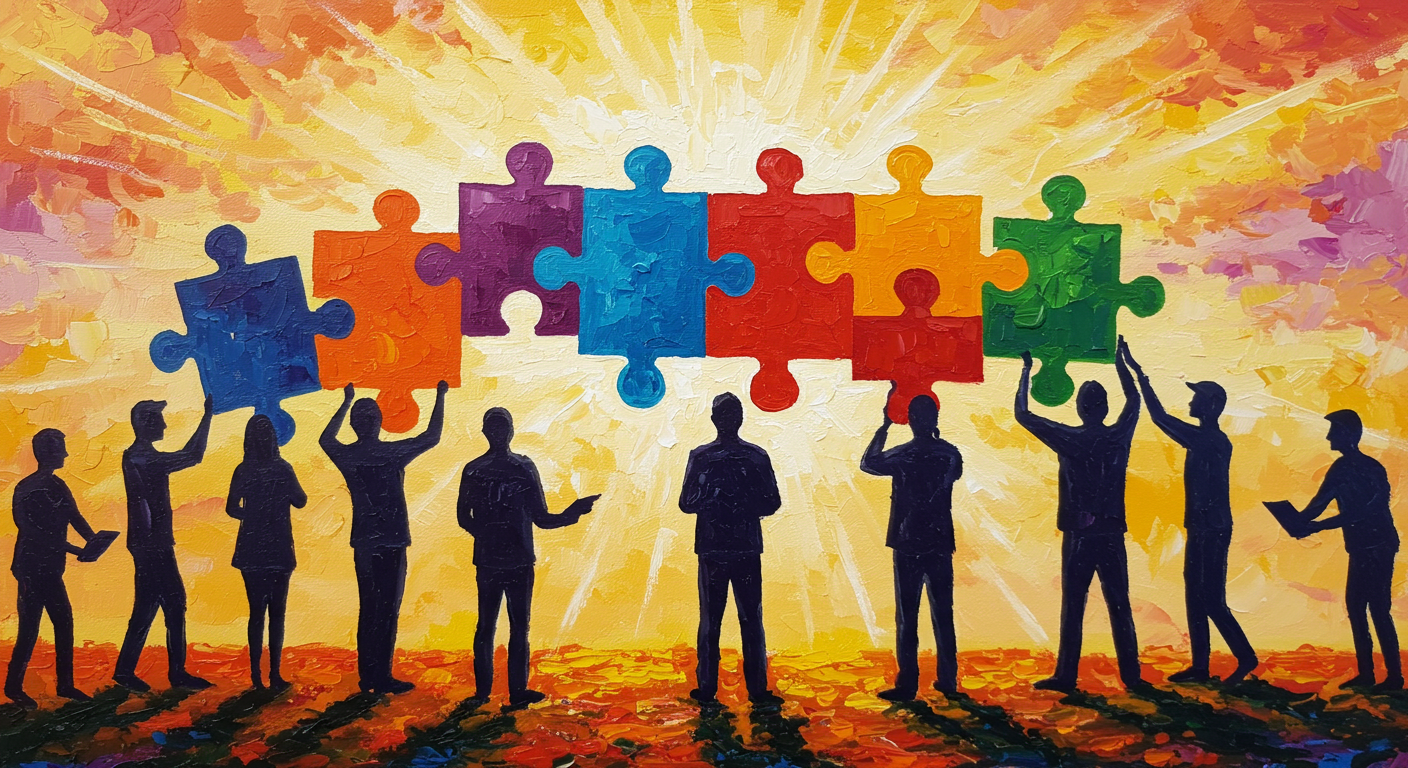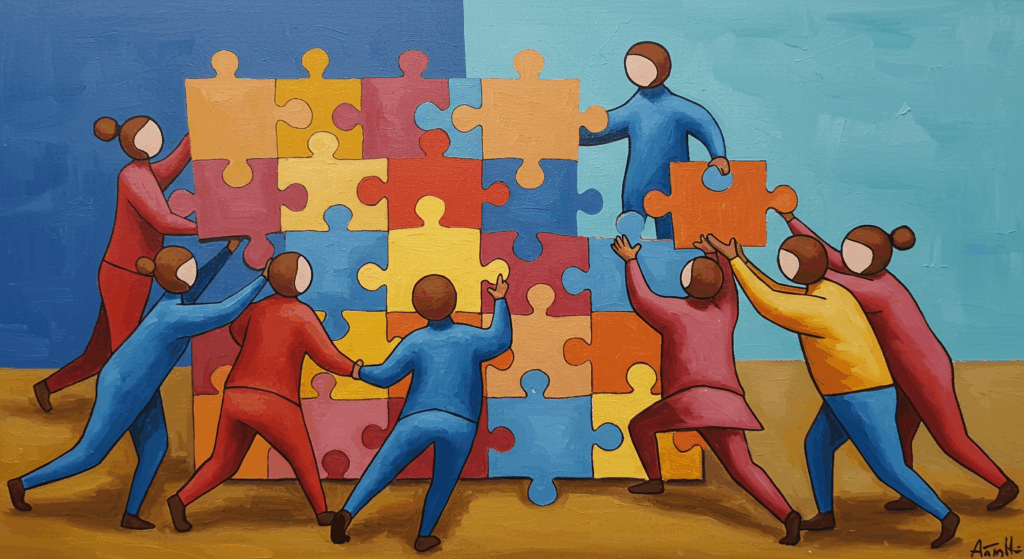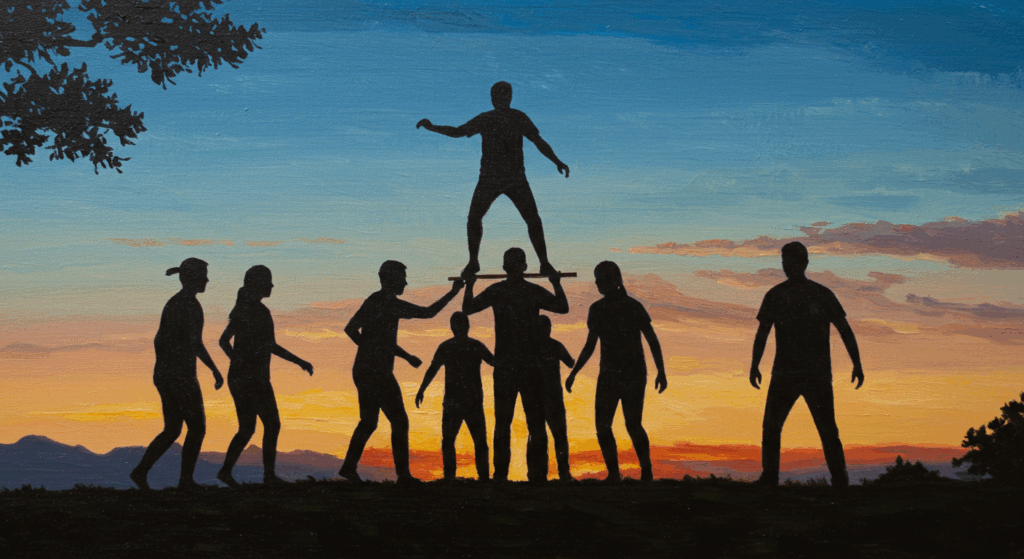If you’ve ever sat in a “fun” corporate icebreaker wondering why we’re tossing a beach ball in a fluorescent conference room at 9:07 AM, same. Team building can be amazing… or painfully awkward. The difference isn’t magic—it’s design. When teamwork team building activities are done with intention, they actually make Monday feel lighter, projects move faster, and people stop Slacking “got a sec?” like it’s a jump scare.
This post is your no-BS guide: how to pick activities that people won’t secretly roll their eyes at, how to weave them into real work, and how to make the energy last longer than a single donut. We’ll talk team synergy (the good kind, not the buzzword salad), goal alignment that doesn’t make everyone yawn, and role-playing that doesn’t feel like theater class trauma. And we’ll end with a few plug-and-play agendas you can use this week. Cool? Cool.
Why Teamwork Still Matters (Even if You’re Remote)
It’s 2025. Projects move at Netflix autoplay speed, priorities pivot like TikTok trends, but half your team is in different time zones listening to wildly different Spotify playlists. A team that clicks—one with real trust and a common rhythm—ships more, fights lewss, and bounces back from chaos faster. That’s the point of teamwork team building activities: they’re not filler, they’re fuel.
Also, ngl, when people like each other even a little, everything’s easier. Feedback lands better. Brainstorms get spicier. And staying late once in a while doesn’t feel like punishment—it feels like the group chat deciding on sushi.
What Are Teamwork Team Building Activities (Really)?
They’re structured moments—quick drills, mini-workshops, full-day sessions—designed to strengthen how humans work together. Not just the vibe, but the skills behind the vibe: listening, decision-making, conflict navigation, shared ownership, and the weird art of getting unstuck when a blocker appears five minutes before the deadline.
Great activities connect to work outcomes. If you’re trying to reduce handoff delays, do something that sharpens clarity and timing. If new hires are quiet, go for psychological safety and small wins. Aslo, iIf your roadmap is fuzzy, try goal alignment exercises that tether daily tasks to bigger outcomes.
Team Synergy: The Secret Sauce
“Team synergy” gets memed, but the meaning is legit: you get more from a group than from the sum of individuals. It’s that moment when ideas connect like Lego bricks, people anticipate each other’s moves, and blockers are handled before they become drama.
Here’s what actually builds team synergy:
- Shared mental models. We have the same picture of “done,” “priority,” and “quality.”
- Coordination fluency. We know who leads what, when to jump in, and how to hand off.
- Trust + candor. I can say the awkward thing without becoming the awkward thing.
- Recovery loops. When we miss, we learn fast and try again—no blame Olympics.
Quick Activities to Boost Team Synergy
1) The 10-Minute “Yes, And” Sprint
Time: 10 minutes team synergy build
How: In a circle (or on video), one person pitches a wild solution to a current work challenge. Everyone else adds one sentence that starts with “Yes, and…”.
Why it works: It trains acceptance before critique, and it builds momentum—the essence of team synergy.
Debrief: What ideas surprised you? What did it feel like to build without saying “but”?
2) Three-Point Pass
Time: 15 minutes
How: Pick a small upcoming task. In pairs, map three micro-handoffs: A → B → A. Define “start,” “ready,” and “done” states for each pass.
Why: Makes invisible steps visible and reduces “oh I didn’t know you needed that.”
Debrief: Which “ready” states were unclear? What labels help us move faster?
3) Constraints Brainstorm
Time: 20 minutes
How: Brainstorm solutions under a silly constraint (only using analog tools, only two steps, only $50).
Why: Constraints force creativity and shared focus—pure team synergy energy.
Debrief: Which constraint actually helped? What should we constrain in real life?
Goal Alignment Without the Yawn
You’ve seen the slide: “Our Mission.” It’s fine. But people need to feel how their work actually ladders up. That’s goal alignment: connecting the dots from the company vision, to team objectives, to what you’re doing Thursday at 2:30 PM.
When goal alignment lands, your standups change. People give updates in outcomes, not activities. Priorities are less debatable. Tradeoffs feel fair. And the team stops shipping beautiful features nobody uses.
A 60–90 Minute Goal Alignment Workshop (Zero Fluff)
Prep: Print the roadmap (or Miro board). Bring markers. Snack bribe optional.
1) Ladder the goals (15 min). Write three levels on a board: Company → Team → Individual. Ask: “What are the top 2–3 company outcomes this quarter?” Then map team goals under each one.
2) Task-to-outcome mapping (25 min). Everyone writes 3–5 tasks on sticky notes, then sticks them under the matching team goal. Anything that doesn’t fit gets a red dot.
3) Ruthless pruning (10 min). For red-dot tasks: kill, pause, or reframe. Practice saying “Not now.”
4) Metrics & milestones (15 min). For each team goal, define one metric and two milestones. Keep it stupid simple (e.g., “Reduce cycle time by 20%” or “NPS +10”).
5) Cadence & check-ins (10 min). Decide how you’ll review progress—weekly standup metric, bi-weekly demo, monthly retro.
Debrief prompts: What became clearer? What still feels fuzzy? Where do we need leadership decisions?
Bonus: Repeat a micro-version (10 minutes) in your weekly meeting: “What did we do last week that moved this metric? What’s the next brick we’re laying?”
Communication Activities That Don’t Feel Forced
Most friction isn’t about competence. It’s about unclear asks, buried context, or Slack novels with zero bulet points. Fixing this is a cheat code.
“Three Levels of Listening”
Time: 15–20 minutes
How: In pairs, Person A describes a real work hurdle for 90 seconds. Person B paraphrases (Level 1), then asks two curiosity questions (Level 2), then guesses the unspoken worry (Level 3). Switch.
Why: It trains deeper listening and reveals assumptions.
Debrief: What did Level 3 feel like? Did you learn something new about the problem?
“Lost in Translation”
Time: 20–25 minutes
How: One person describes a simple diagram while the other draws it—no screen share.
Why: Forces precision. Builds shared vocabulary.
Pro tip: Add one rule each round (“no adjectives,” “no pointing words”) to increase difficulty.
Async Clarity Drill
Time: 10 minutes
How: As a team, create a message template for requests: Context → Ask → Definition of Done → Owner → Deadline → Dependencies.
Why: Saves hours of back-and-forth. Your future self will send you a fruit basket.
Role-Playing That Doesn’t Feel Cringe
Stay with me. “Role-playing” gets a bad rap because it’s often random or performative. But good role-playing is just rehearsal for high-stakes moments. Actors rehearse. Athletes scrimmage. We can, too.
Role-Playing for Conflict Resolution
Scenario: Two teammates disagree on approach (speed vs. quality).
Roles: A (Speed), B (Quality), C (Facilitator).
Flow (12–15 min):
- Each side makes a 60-second case.
- Reflect back what you heard (no rebuttal).
- Name the shared objective (goal alignment cameo!).
- Co-create a hybrid plan: where to go fast, where to set guardrails.
Debrief: What solved it—facts, empathy, or process?
Role-Playing for Customer Empathy
Scenario: A long-time client is frustrated after a buggy release.
Roles: PM, Engineer, “Customer,” Observer.
Flow (12 min):
- PM + Engineer craft a 2-minute apology and plan.
- Customer escalates with real-feel objections.
- Team negotiates scope honestly (no vaporware promises).
Debrief: What phrasing calmed the room? What made it worse? Capture language you want to reuse.
Role-Playing for Cross-Functional Handoffs
Scenario: Marketing needs a date. Engineering is juggling incidents.
Roles: Eng Lead, Marketer, Ops.
Goal: Agree on a realistic date and a contingency plan.
Why it works: It surfaces hidden dependencies and clarifies what “done” means. And it’s way less stressful to practice when Slack isn’t on fire.
Creative Problem-Solving Games (That Map to Work)
Puzzle Sprint
Time: 30 minutes
How: Give teams a physical puzzle (or a constraint puzzle online). Assign rotating roles: Leader, Communicator, Builder, Auditor. Switch every 5 minutes.
Why: Teaches rotation, clarity, and documentation under time pressure.
Tie-back: “Which role felt natural? Which was uncomfortable? What does that say about our sprint roles?”
Reverse Hackathon
Time: 60–90 minutes
How: Instead of building something, teams remove complexity from a current workflow. Winner is the smallest number of steps without losing quality.
Why: Great for ops-heavy teams drowning in process debt.
Deliverable: A 1-page “Before vs. After” SOP.
Two Truths & a Tool
Time: 15 minutes
How: Each person shares two tools they love and one they tried that flopped (keep it friendly).
Why: Cross-pollinates tips and avoids the “secret hacks” trap. This one feels like a chill podcast.
Trust & Psychological Safety (The Non-Corny Kind)
Trust doesn’t require trauma bonding. It’s built in small, consistent ways.
The 5% Vulnerability Share
Time: 10 minutes
How: Each person shares something slightly vulnerable (not overshare-y): a work insecurity, a skill they want to grow, a recent mistake and lesson.
Ground rules: No fixing. No “you should.” Just thank and move on.
Why: Normalizes imperfection, opens the door for help requests later.
Red/Yellow/Green Check-In
Time: 5 minutes at the top of a meeting
How: Each person says their color and one sentence why.
Rules: Greens don’t monologue; Reds get first help.
Why: Fast signal. Helps managers support humans, not just tickets.
For Hybrid and Remote Teams
If your squad is scattered, teamwork team building activities still work—just lean into async and shorter synchronous bursts.
Async Coffee Roulette
Tool: Your calendar + a randomizer (or a simple script)
How: Pair people across functions for 20-minute chats each week. Provide a prompt: “What’s one tiny workflow upgrade you made recently?”
Why: Builds weak ties that become strong bridges.
Miro (or FigJam) Show & Tell
Time: 25 minutes
How: One teammate demos a board: “Here’s how I track experiments.” Everyone steals one element to use next week.
Why: Knowledge-sharing without a boring wiki.
Budget “Escape Room”
Time: 30–40 minutes
How: Use a free online puzzle pack or build three riddles related to your team’s domain.
Why: It’s fun, sure, but the real value is observing how the team searches, assigns tasks, and shares clues.
Outdoor or Onsite Activities That Actually Help
45-Minute Walkshop
Format: Walk in pairs for 15 minutes, switch partners twice. Prompt: “What’s one assumption we’re making about our users that might be wrong?”
Why: Movement + sunlight = better thinking. Also breaks cliques.
Purposeful Scavenger Hunt
Not just “find a red leaf.” But, give challenges tied to values or product insights: “Photograph an example of terrible wayfinding,” Then, “Collect an example of a brand keeping a promise,” “Find a moment of inclusive design.”
Debrief: Share photos, extract patterns, pick one idea to test next sprint.
Volunteer Together (Mini)
Time: 2–3 hours
Pick a local cause (or a remote micro-volunteering task). Assign roles like a project: logistics, comms, quality.
Why: Builds pride and coordination under light pressure.
Designing a Team Building Day (Sample Schedules)
You don’t need a whole offsite. A well-structured half day beats an unfocused full day where everyone just wants to nap.
Half-Day “Alignment + Synergy” (4 hours)
- Warm-up (10 min): Red/Yellow/Green check-in
- Goal Alignment Workshop (70 min): Ladder goals, map tasks, prune, metrics
- Break (10 min)
- Synergy Sprints (40 min): “Yes, and” + Three-Point Pass
- Role-Playing (40 min): Cross-functional handoff scenario
- Break (10 min)
- Process Hack (50 min): Reverse Hackathon on one workflow
- Commitments (10 min): One change per person, shared doc
“Remote Rhythm Builder” (2 hours, fully virtual)
- Icebreaker (10 min): Two Truths & a Tool
- Communication Drill (20 min): Lost in Translation
- Mini Role-Play (20 min): Customer empathy call
- Async Cadence (15 min): Design your team’s message template
- Break (5 min)
- Goal Alignment Lite (30 min): One metric, two milestones per team goal
- Close (20 min): 5% Vulnerability Share + one shoutout
“Creative Problem Day” (3 hours)
- Warm-up (10 min): Red/Yellow/Green
- Puzzle Sprint (30 min)
- Break (10 min)
- Constraints Brainstorm (30 min)
- Reverse Hackathon (60 min)
- Demos + Votes (30 min)
- Commit + Calendar (10 min): Who owns which change by when?
How to Keep the Momentum (So It’s Not Just a Cute Day)
1) Bake it into rituals. Add one micro-activity to your weekly standup (e.g., a 5-minute “ready state” check for this week’s handoffs).
2) Track one metric. Pick something the team cares about: cycle time, PR review time, customer time-to-first-value, bug reopen rate. Tiny wins, tracked, become big wins.
3) Protect 10%. Reserve 10% of team time for improvement work that came out of your activities. If you don’t budget it, it won’t happen.
4) Rotate facilitation. Let different people lead so it spreads ownership and uncovers quiet leadership.
5) Retros that bite (in a good way). Close every month with “Start/Stop/Continue,” then actually start/stop/continue.
Common Pitfalls (And How to Dodge Them)
- Forced fun. If folks are introverted or slammed, don’t do karaoke. Pick lower-stakes drills with clear work tie-ins.
- No debrief. The learning happens in the debrief—always connect activity → work reality.
- No follow-through. Turn insights into one-page action docs with owners and dates.
- Too much, too soon. Start with 10–20 minute activities and build up.
- Ignoring context. A team navigating layoffs needs different activities (safety, clarity) than a team drowning in demand (prioritization, boundaries).
Real Talk: What People Actually Want
They want to feel useful. They want to know where they’re going (goal alignment). Also how they fit (role clarity), and that they can speak up without getting roasted. Twey want tiny wins that add up. They want to work with humans who say “my bad”, Also, “I got you” in the same week. Teamwork team building activities done right give people that.
Tie It All Together: Team Synergy, Goal Alignment, Role-Playing
Think of these three as your loop:
- Goal alignment sets the north star and cuts the noise.
- Team synergy is how you travel—smooth handoffs, trust, shared tempo.
- Role-playing is your rehearsal so crunch-time doesn’t break you.
Run the loop monthly. Keep it light, but keep it practical, and keep receipts (notes + metrics). If your team feels 10% tighter each month, you’ll feel it in ship dates and Slack tone.
Three Ready-to-Use Mini-Agendas
“The Monday Tune-Up” (30 minutes)
- 5 min: Red/Yellow/Green check-in
- 10 min: Task-to-Outcome mapping (each person moves one task under a team goal)
- 10 min: Role-playing one tough convo this week (manager ↔ IC, or peer ↔ peer)
- 5 min: One commitment per person
“Hand-off Hygiene” (25 minutes)
- 5 min: Define “ready state” for current sprint’s top handoff
- 15 min: Three-Point Pass drill with live docs
- 5 min: Document the final checklist in your repo/wiki
“Creative Jam” (40 minutes)
- 10 min: Yes, And Sprint
- 20 min: Constraints Brainstorm on a gnarly problem
- 10 min: Pick one micro-experiment; schedule it now
FAQs (Because Someone Will Ask)
How often should we do this?
Start with one 20–40 minute block per week. Add a 90-minute workshop monthly. Quarterly, do a half-day to reset goal alignment.
What if my team is allergic to “activities”?
Rename them. Call them “work sprints,” “handoff labs,” or “customer call rehearsals.” Keep the vibe chill and the debriefs practical.
Do we need a facilitator?
It helps, but rotate the role. Give the facilitator a simple script and also a timer. (Tip: the best facil leads ask more questions than they answer.)
How big can the group be?
8–12 is sweet. Bigger groups should split into pods and reconvene to share insights.
What about budget?
You can do 90% of this with sticky notes, a timer, and a shared doc. If you add budget, spend it on a great venue or a half-day coach for conflict and feedback skills.
A Quick Word on Accessibility & Inclusion
- Offer alternatives to high-energy games. Also, let people opt into roles that suit their energy or mobility.
- Provide agendas in advance and allow cameras-off participation.
- Use captions in virtual sessions.
- Rotate speaking order so quieter folks don’t get steamrolled.
- Celebrate wins in multiple formats (not everyone loves public praise, some prefer a DM or note).
Your 2-Week Starter Plan
Week 1:
- Run the 30-minute Monday Tune-Up.
- Adopt the Async Clarity template for all requests.
- Also end with a 5% Vulnerability Share.
Week 2:
- Do the Hand-off Hygiene session.
- Try one role-playing scenario (customer call or cross-functional date setting).
- Close with a 20-minute Goal Alignment Lite: one metric, two milestones.
Track one thing: pick a baseline (e.g., average cycle time) and check it again in two weeks. If it nudges in the right direction, keep going. If not, adjust. It’s like a gym plan for your team—you don’t get abs from one plank (tragically), but you do get stronger when you show up regularly.
Final Take
Teamwork team building activities aren’t about pizza, but they’re about patterns. When you design moments that create team synergy, aim for goal alignment, and rehearse with role-playing, you build a system that survives busy seasons, tough feedback, and those days when every SaaS tool decides to nap.
Start small. Keep it human. Measure what matters. Then keep stacking bricks.
You’ve got this. Pick one activity from above, then drop 30 minutes on the calendar, and invite the squad. If you want, tell them I said there will be snacks. Now go build something great together — then brag about it a little. You earned it.









